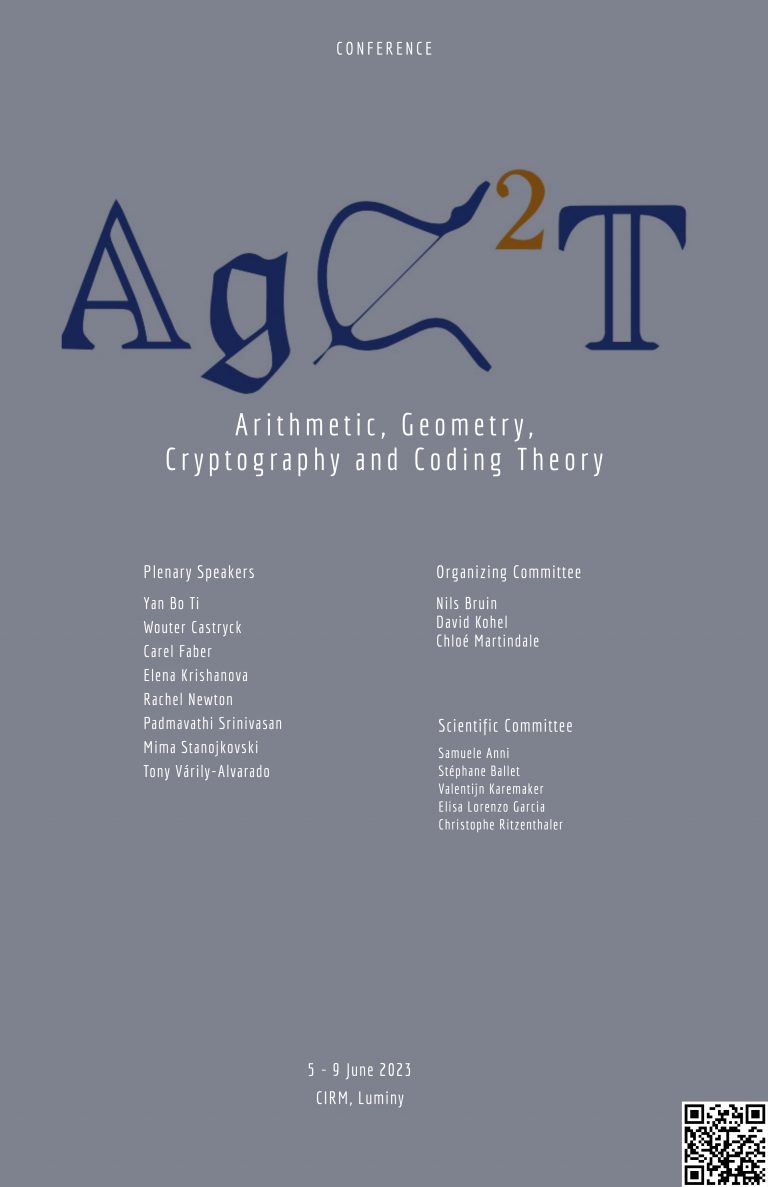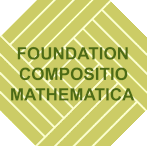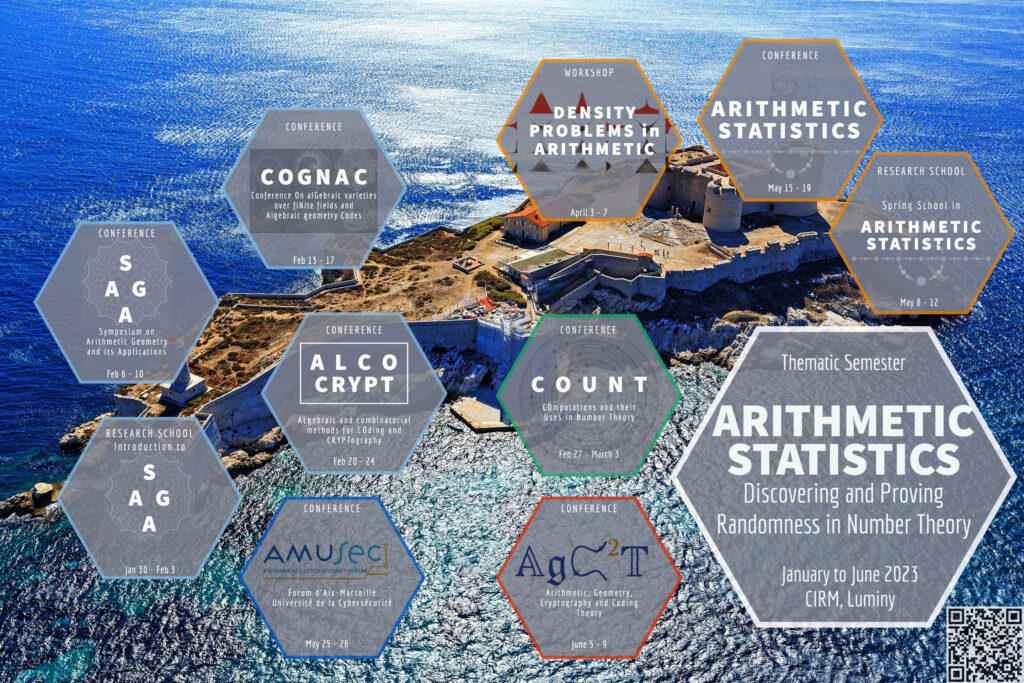MULTIYEAR PROGRAM
CONFERENCE
Arithmetic, Geometry, Cryptography and Coding Theory
Arithmétique, Géométrie, Cryptographie et Théorie des Codes
5 – 9 June, 2023

Steering Committee
Comité de pilotage
Samuele Anni (Aix-Marseille Université)
Stéphane Ballet (Aix-Marseille Université)
Valentijn Karemaker (Utrecht University)
Elisa Lorenzo Garcia (Université de Neuchâtel)
Christophe Ritzenthaler (Université de Rennes)
Organizing Committee
Comité d’organisation
Nils Bruin (Simon Fraser University)
David Kohel (Aix-Marseille Université)
Chloé Martindale (University of Bristol)

Our goal is to organise a conference devoted to interactions between pure mathematics (in particular arithmetic and algebraic geometry) and information theory (especially cryptography and coding theory). This conference will be the nineteenth edition, with the first one held in 1987, in a series that has traditionally brought together some of the top specialists in the domains of arithmetic, geometry, and information theory. The corresponding international community is very active and all of the concerned research domains are developing and expanding rapidly.
The conference is therefore also an important occasion for junior mathematicians (graduate students and postdocs) to interact with established researchers in order to exchange ideas. We aim to create an inclusive atmosphere and to encourage forging new connections between researchers of various different backgrounds.
The conference talks will be devoted to recent advances in arithmetic and algebraic geometry and number theory, with a special emphasis on algorithmic and effective results and applications of these fields to information theory.
The conference will last one week and will be organized as follows :
– There will be one or two plenary talks each day, at the start of each session. They will be given by established researchers, some of whom are new to the established AGC2T community; this will allow for the introduction of emerging topics to the community, which may give rise to applications of arithmetic or algebraic geometry to information theory.
– There will be several shorter specialized talks in each session, often delivered by junior mathematicians.
As with the previous editions of the AGC2T, we aim publish conference proceedings as a special volume of the Contemporary Mathematics collection of the AMS.
Conference Topics
- Algebraic and arithmetic geometry over finite fields and global fields.
- Number theory, especially explicit and algorithmic.
- Algebro-geometric codes constructed from curves and higher-dimensional algebraic varieties over finite fields and global fields.
- Arithmetic and geometric aspects of cryptography (symmetric, public key, and post-quantum) and cryptanalysis.
Notre objectif est d’organiser une conférence consacrée aux interactions entre les mathématiques théoriques (en particulier l’arithmétique et la géométrie algébrique) et les sciences de l’information (en particulier le codage et la cryptographie). Cette conférence serait la dix-neuvième édition d’un colloque réunissant traditionnellement depuis 1987 des spécialistes du niveau le plus haute des domaines de l’arithmétique, la géométrie et la théorie de l’information. La communauté internationale en question est très active, tous les domaines concernés évoluant rapidement avec le temps.
La conférence est par conséquent une occasion importante pour des jeunes mathématiciens (doctorants et post- doctorants) d’interagir avec des chercheurs plus expérimentés dans le but d’échanger de nouvelles idées. Nous visons à créer une atmosphère inclusive et à encourager la création de nouvelles connexions entre des chercheurs d’horizons différents.
Les exposés porteront sur la présentation des avancées récentes en géométrie algébrique et en théorie des nombres, avec un accent particulier sur les résultats effectifs et algorithmiques et les applications de ces domaines à la théorie de l’information.
La conférence durera une semaine et sera structurée de la manière suivante.
– Chaque jour auront lieu une à deux conférences plénières en début de session. Elles seront assurées par des chercheurs confirmés. Nous souhaiterions qu’une partie de ces sessions plénières soient assurées par des chercheurs extérieurs à la communauté introduisant des problématiques émergentes pouvant donner lieu à de nouvelles applications de l’arithmétique et/ou de la géométrie algébrique.Le reste des journées sera dédié à des exposés courts spécialisés par de jeunes chercheu.r/se.s.
Comme dans les éditions précédentes, à l’issue de la conférence, nous souhaitons éditer des actes dans la collection Contemporary Mathematics de l’AMS.
Thèmes du Colloque
- Géométrie algébrique et arithmétique sur des corps finis et des corps globaux.
- Théorie des nombres, spécialement explicit et algorithmique.
- Théorie des codes correcteurs algébriques et géométriques construits à partir de courbes algébriques ou de variétés de dimension supérieure sur des corps finis.
- Aspects arithmétiques et géométriques de la cryptographie et cryptanalyse (symétrique, à clé publique et post-quantique).
PLENARY SPEAKERS
Yan Bo Ti (DSO Singapore) Isogeny-based cryptography on the (abelian) surface
Wouter Castryck (Catholic University of Leuven) An efficient break of the supersingular isogeny Diffie-Hellman protocol
Carel Faber (Utrecht University) Arithmetic and geometry of the moduli space of curves
Elena Kirshanova (Immanuel Kant Baltic Federal University) Construction-D lattice from Garcia-Stichtenoth tower code
Rachel Newton (King’s College London) Counting S4 and S5 extensions satisfying the Hasse norm principle
Padmavathi Srinivasan (ICERM Brown University) Computing Ceresa classes of curves
Mima Stanojkovski (University of Trente) The geometry of stable lattices in Bruhat-Tits buildings
Tony Várily-Alvarado (Rice University) Probabilistic approaches to rational points on algebraic surfaces
CONTRIBUTED TALKS
Yves Aubry (Université de Toulon) Closed points on curves over finite fields
Elena Berardini (CNRS, Université de Bordeaux) Algebraic geometry codes in the sum-rank metric
Jeremy Booher (University of Florida) Geometric Iwasawa theory
Thomas Bouchet (Université Côte d’Azur) Invariants of genus 4 curves
Irene Bouw (Ulm University) Conductor and invariants of Ciani curves
Mar Curcó Iranzo (Utrecht University) Generalised Jacobians of modular curves and their Q-rational torsion
Martin Djukanovic (Leiden University) Split Jacobians with isogenous components
Damián Gvirtz-Chen (University of Glasgow) Hilbert Property for Hilbert modular surfaces
Tomoyoshi Ibukiyama (Osaka University) Dimensions of paramodular forms with Atkin-Lehner signs.
Kiran Kedlaya (University of California San Diego) The relative class number one problem for function fields
Harun Kir (Queen’s University Canada) The refined Humbert invariant for a given automorphism group of a genus 2 curve with some applications
Eda Kirimli (University of Bristol) Isogeny graphs of abelian surfaces
Dimitri Koshelev (ENS de Lyon) Batching Cipolla-Lehmer-Müller’s square root algorithm with hashing to elliptic curves
Boris Kunyavskii (Bar-Ilan University) Tori and surfaces violating a local-to-global principle for rationality
Avi Kulkarni (Dartmouth College) Intersections of symmetric determinantal varieties, theta characteristics, and an application to arithmetic
Christophe Levrat (Sorbonne Université) Computing the cohomology of π_1-modules trivialised by hyperelliptic covers
Luciano Maino (University of Bristol) Practical encryption from isogenies between elliptic products
Stefano Marseglia (Utrecht University) Cohen-Macaulay type of endomorphism rings of abelian varieties over finite fields
Travis Morrison (Virginia Tech) Computing supersingular endomorphism rings with inseparable endomorphisms
Steffen Müller (University of Groningen) Algorithms for hyperelliptic Mumford curves
Jade Nardi (CNRS, Université de Rennes) Goppa-like AG codes from Cab curves and the dimension of the square of their dual
Ciaran Schembri (Dartmouth College) Torsion points on abelian surfaces with many endomorphisms
Michael Tsfasman (CNRS, Russian Academy of Sciences) Quadratic residue patterns, elliptic curves, and a K3 surface
Yuri Zarhin (Pennsylvania State University) Central simple representations and superelliptic jacobians
SPONSORS








